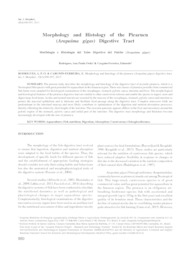Morphology and histology of the Pirarucu (Arapaima gigas) digestive tract.
Morphology and histology of the Pirarucu (Arapaima gigas) digestive tract.
Author(s): RODRIGUES, A. P. O.; CARGNIN-FERREIRA, E.
Summary: The present study describes the morphology and histology of the digestive tract of juvenile pirarucu, which is a Neotropical fish species with great potential for aquaculture in the Amazon region. Three size classes of pirarucu juveniles from commercial fish farms were sampled for histological examination of the oesophagus, stomach, pyloric caeca, intestine and liver. The morphological and histological features of the pirarucu digestive tract are similar to other carnivorous teleosts and enable the species to ingest, store and digest large food items. Acidic and neutral mucins are secreted by the mucosa of the oesophagus, stomach, pyloric caeca and intestine to protect the mucosal epithelium and to lubricate and facilitate food passage along the digestive tract. Complex transverse folds are predominant in the intestinal mucosa and most likely contribute to optimization of the digestion and nutrient absorption processes, thereby offsetting the relatively short length of the intestine. The exocrine pancreas appears diffuse in the liver and mesentery around the pyloric region of the stomach, pyloric caeca and initial part of the intestine. The digestive tract morphology and thickness become increasingly developed with the size of pirarucu.
Publication year: 2017
Types of publication: Journal article
Observation
Some of Embrapa's publications are published as ePub files. To read them, use or download one of the following free software options to your computer or mobile device. Android: Google Play Books; IOS: iBooks; Windows and Linux: Calibre.
Access other publications
Access the Agricultural Research Database (BDPA) to consult Embrapa's full library collection and records.
Visit Embrapa Bookstore to purchase books and other publications sold by Embrapa.

